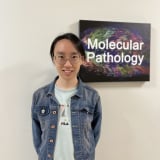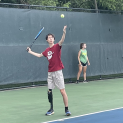Novel mechanisms and therapeutic targeting of chemoresistant rhabdomyosarcoma

Rhabdomyosarcoma (RMS) is a common and aggressive childhood cancer that arises from muscle. Current treatment includes radiation, chemotherapy, and surgery. However, 30% of patients eventually develop resistance to the drugs used to treat their tumors and their tumors reform. Sadly, nearly all patients that develop therapy resistant RMS ultimately die of their tumors. Since treatment strategies for RMS have not changed in 40 years, there is a critical need to develop new therapies to kill RMS tumors, including identifying drugs that can re-sensitize them to the same chemotherapies commonly used to treat patients. My work will identify the mechanisms by which RMS tumors develop resistance to standard chemotherapy and a newly innovated drug combination that is in clinical trials based on our lab’s work. I will also assess if an FDA-approved drug can reverse resistance, providing hope to move my work into new clinical trials in the future.
Project Goal:
My work will identify new combinations of drugs to kill chemotherapy-resistant muscle cancer. My previous work has identified a pathway called PI3K/AKT that is activated and drives drug resistance in RMS. Here, aim 1 will define how the PI3K/AKT pathway is turned on in chemotherapy-resistant tumors. Aim 2 will assess a new drug combination for the ability to kill RMS tumors that are resistant to standard chemotherapy and a newly innovated drug combination that is in clinical trials based on our lab’s work. My research will explain why certain drug combinations work better at killing RMS tumors and have a high likelihood of identifying better treatments for this type of cancer. My ultimate goal is to find medicines that can kill the chemotherapy-resistant RMS and advance my research to the next stage of treating patientsin clinic. Finally, it is possible that the same processes are used in other cancers, raising hopes that my work will also lead to new treatments for other childhood cancers.
Project Update 2025:
In this project, we are studying how rhabdomyosarcoma (RMS) becomes resistant to chemotherapy, and how we might overcome that resistance. Our group previously identified Olaparib PARP inhibitor and temozolomide DNA damaging agent (OT) as a promising drug combination that kills RMS cells. However, drug resistance still emerges after long-time treatment. My mechanistic studies found the activation of the PIK3CA/AKT pathway drives therapy resistance to OT combination therapy. To study the upstream regulators of the PIK3CA/AKT pathway, I isolated individual cancer cells that had become resistant to OT treatment. Over time, I grew these cells without giving them any drugs. Interestingly, most of these cells eventually became sensitive to OT again. This indicates that their resistance was not due to permanent changes in DNA, but likely caused by reversible mechanisms that control how genes are turned on or off—known as "epigenetics." Next, we tested whether similar changes happen in cells resistant to the standard therapy, VAC. We found that some VAC-resistant cancer cells also switched on the PIK3CA/AKT pathway that helps them survive treatment. In these cases, adding a drug called alpelisib, which blocks this pathway, made the cancer cells vulnerable to treatment again. In fact, combining OT with alpelisib killed all the VAC-resistant cells that had activated this pathway. These results are promising because they show that we can potentially overcome resistance to treatment by targeting these specific pathways and I will continue working on finding the upstream epigenetic regulators.

